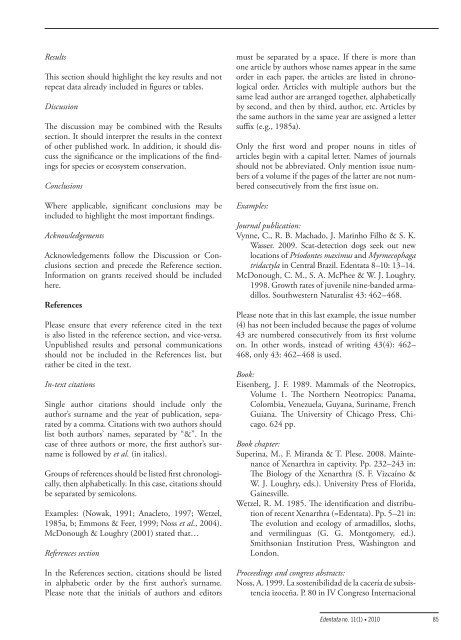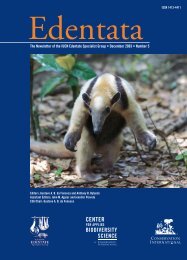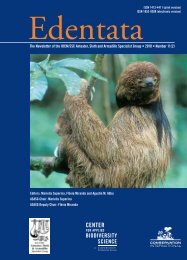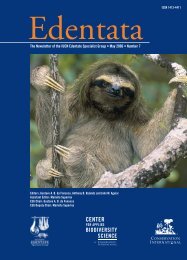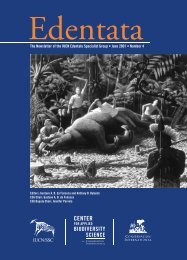Edentata 11(1) - Anteater, Sloth & Armadillo Specialist Group
Edentata 11(1) - Anteater, Sloth & Armadillo Specialist Group
Edentata 11(1) - Anteater, Sloth & Armadillo Specialist Group
You also want an ePaper? Increase the reach of your titles
YUMPU automatically turns print PDFs into web optimized ePapers that Google loves.
Results<br />
This section should highlight the key results and not<br />
repeat data already included in figures or tables.<br />
Discussion<br />
The discussion may be combined with the Results<br />
section. It should interpret the results in the context<br />
of other published work. In addition, it should discuss<br />
the significance or the implications of the findings<br />
for species or ecosystem conservation.<br />
Conclusions<br />
Where applicable, significant conclusions may be<br />
included to highlight the most important findings.<br />
Acknowledgements<br />
Acknowledgements follow the Discussion or Conclusions<br />
section and precede the Reference section.<br />
Information on grants received should be included<br />
here.<br />
References<br />
Please ensure that every reference cited in the text<br />
is also listed in the reference section, and vice-versa.<br />
Unpublished results and personal communications<br />
should not be included in the References list, but<br />
rather be cited in the text.<br />
In-text citations<br />
Single author citations should include only the<br />
author’s surname and the year of publication, separated<br />
by a comma. Citations with two authors should<br />
list both authors’ names, separated by “&”. In the<br />
case of three authors or more, the first author’s surname<br />
is followed by et al. (in italics).<br />
<strong>Group</strong>s of references should be listed first chronologically,<br />
then alphabetically. In this case, citations should<br />
be separated by semicolons.<br />
Examples: (Nowak, 1991; Ana cleto, 1997; Wetzel,<br />
1985a, b; Emmons & Feer, 1999; Noss et al., 2004).<br />
McDonough & Loughry (2001) stated that…<br />
References section<br />
In the References section, citations should be listed<br />
in alphabetic order by the first author’s surname.<br />
Please note that the initials of authors and editors<br />
must be separated by a space. If there is more than<br />
one article by authors whose names appear in the same<br />
order in each paper, the articles are listed in chronological<br />
order. Articles with multiple authors but the<br />
same lead author are arranged together, alphabetically<br />
by second, and then by third, author, etc. Articles by<br />
the same authors in the same year are assigned a letter<br />
suffix (e.g., 1985a).<br />
Only the first word and proper nouns in titles of<br />
articles begin with a capital letter. Names of journals<br />
should not be abbreviated. Only mention issue numbers<br />
of a volume if the pages of the latter are not numbered<br />
consecutively from the first issue on.<br />
Examples:<br />
Journal publication:<br />
Vynne, C., R. B. Machado, J. Marinho Filho & S. K.<br />
Wasser. 2009. Scat-detection dogs seek out new<br />
locations of Priodontes maximus and Myrmecophaga<br />
tridactyla in Central Brazil. <strong>Edentata</strong> 8–10: 13–14.<br />
McDonough, C. M., S. A. McPhee & W. J. Loughry.<br />
1998. Growth rates of juvenile nine-banded armadillos.<br />
Southwestern Naturalist 43: 462–468.<br />
Please note that in this last example, the issue number<br />
(4) has not been included because the pages of volume<br />
43 are numbered consecutively from its first volume<br />
on. In other words, instead of writing 43(4): 462–<br />
468, only 43: 462–468 is used.<br />
Book:<br />
Eisenberg, J. F. 1989. Mammals of the Neotropics,<br />
Volume 1. The Northern Neotropics: Panama,<br />
Colombia, Venezuela, Guyana, Suriname, French<br />
Guiana. The University of Chicago Press, Chicago.<br />
624 pp.<br />
Book chapter:<br />
Superina, M., F. Miranda & T. Plese. 2008. Maintenance<br />
of Xenarthra in captivity. Pp. 232–243 in:<br />
The Biology of the Xenarthra (S. F. Vizcaíno &<br />
W. J. Loughry, eds.). University Press of Florida,<br />
Gainesville.<br />
Wetzel, R. M. 1985. The identification and distribution<br />
of recent Xenarthra (=<strong>Edentata</strong>). Pp. 5–21 in:<br />
The evolution and ecology of armadillos, sloths,<br />
and vermilinguas (G. G. Montgomery, ed.).<br />
Smithsonian Institution Press, Washington and<br />
London.<br />
Proceedings and congress abstracts:<br />
Noss, A. 1999. La sostenibilidad de la cacería de subsistencia<br />
izoceña. P. 80 in IV Congreso Internacional<br />
<strong>Edentata</strong> no. <strong>11</strong>(1) • 2010 85


